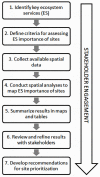Rapid Assessment of Ecosystem Service Co-Benefits of Biodiversity Priority Areas in Madagascar
- PMID: 28006005
- PMCID: PMC5179119
- DOI: 10.1371/journal.pone.0168575
Rapid Assessment of Ecosystem Service Co-Benefits of Biodiversity Priority Areas in Madagascar
Abstract
The importance of ecosystems for supporting human well-being is increasingly recognized by both the conservation and development sectors. Our ability to conserve ecosystems that people rely on is often limited by a lack of spatially explicit data on the location and distribution of ecosystem services (ES), the benefits provided by nature to people. Thus there is a need to map ES to guide conservation investments, to ensure these co-benefits are maintained. To target conservation investments most effectively, ES assessments must be rigorous enough to support conservation planning, rapid enough to respond to decision-making timelines, and often must rely on existing data. We developed a framework for rapid spatial assessment of ES that relies on expert and stakeholder consultation, available data, and spatial analyses in order to rapidly identify sites providing multiple benefits. We applied the framework in Madagascar, a country with globally significant biodiversity and a high level of human dependence on ecosystems. Our objective was to identify the ES co-benefits of biodiversity priority areas in order to guide the investment strategy of a global conservation fund. We assessed key provisioning (fisheries, hunting and non-timber forest products, and water for domestic use, agriculture, and hydropower), regulating (climate mitigation, flood risk reduction and coastal protection), and cultural (nature tourism) ES. We also conducted multi-criteria analyses to identify sites providing multiple benefits. While our approach has limitations, including the reliance on proximity-based indicators for several ES, the results were useful for targeting conservation investments by the Critical Ecosystem Partnership Fund (CEPF). Because our approach relies on available data, standardized methods for linking ES provision to ES use, and expert validation, it has the potential to quickly guide conservation planning and investment decisions in other data-poor regions.
Conflict of interest statement
The authors have declared that no competing interests exist.
Figures








Similar articles
-
Ecosystem services and opportunity costs shift spatial priorities for conserving forest biodiversity.PLoS One. 2014 Nov 13;9(11):e112557. doi: 10.1371/journal.pone.0112557. eCollection 2014. PLoS One. 2014. PMID: 25393951 Free PMC article.
-
Co-occurrence of biodiversity, carbon storage, coastal protection, and fish and invertebrate production to inform global mangrove conservation planning.Sci Total Environ. 2023 Dec 15;904:166357. doi: 10.1016/j.scitotenv.2023.166357. Epub 2023 Aug 16. Sci Total Environ. 2023. PMID: 37595913
-
Assessing ecosystem service provision under climate change to support conservation and development planning in Myanmar.PLoS One. 2017 Sep 21;12(9):e0184951. doi: 10.1371/journal.pone.0184951. eCollection 2017. PLoS One. 2017. PMID: 28934282 Free PMC article.
-
Incorporating environmental costs of ecosystem service loss in political decision making: A synthesis of monetary values for Germany.PLoS One. 2019 Feb 13;14(2):e0211419. doi: 10.1371/journal.pone.0211419. eCollection 2019. PLoS One. 2019. PMID: 30759137 Free PMC article.
-
Ecosystem services studies in Turkey: A national-scale review.Sci Total Environ. 2022 Oct 20;844:157068. doi: 10.1016/j.scitotenv.2022.157068. Epub 2022 Jul 1. Sci Total Environ. 2022. PMID: 35787907 Review.
Cited by
-
Developing China's Ecological Redline Policy using ecosystem services assessments for land use planning.Nat Commun. 2018 Aug 2;9(1):3034. doi: 10.1038/s41467-018-05306-1. Nat Commun. 2018. PMID: 30072771 Free PMC article.
-
Model ensembles of ecosystem services fill global certainty and capacity gaps.Sci Adv. 2023 Apr 7;9(14):eadf5492. doi: 10.1126/sciadv.adf5492. Epub 2023 Apr 7. Sci Adv. 2023. PMID: 37027474 Free PMC article.
-
Mapping of biodiversity hubs and key ecosystem services as a tool for shaping optimal areas for conservation.PLoS One. 2021 Aug 17;16(8):e0253151. doi: 10.1371/journal.pone.0253151. eCollection 2021. PLoS One. 2021. PMID: 34403432 Free PMC article.
-
Investigating Foraging Niches for Tenrecs, Bats, and Rodents at Betampona Réserve Naturelle Intégrale (Central Eastern Madagascar) Using Stable Carbon and Nitrogen Isotopes in Fur and Bone.Animals (Basel). 2025 Aug 19;15(16):2423. doi: 10.3390/ani15162423. Animals (Basel). 2025. PMID: 40867751 Free PMC article.
-
Combining Co$ting Nature and Suitability Modeling to Identify High Flood Risk Areas in Need of Nature-Based Services.Land (Basel). 2021 Aug;10(8):853. doi: 10.3390/land10080853. Epub 2021 Aug 15. Land (Basel). 2021. PMID: 34532079 Free PMC article.
References
-
- Millennium Ecosystem Assessment. Ecosystems and Human Well-being: Synthesis [Internet]. Washington, DC: Island Press; 2005. http://www.millenniumassessment.org/documents/document.356.aspx.pdf
-
- Costanza R, de Groot R, Sutton P, van der Ploeg S, Anderson SJ, Kubiszewski I, et al. Changes in the global value of ecosystem services. Global Environmental Change. 2014. May;26:152–8.
-
- Maes J, Egoh B, Willemen L, Liquete C, Vihervaara P, Schägner JP, et al. Mapping ecosystem services for policy support and decision making in the European Union. Ecosystem Services. 2012. July;1(1):31–9.
-
- TEEB. The Economics of Ecosystems and Biodiversity: Ecological and Economic Foundations [Internet]. Routledge; 2010. 455 p. http://www.teebweb.org/our-publications/teeb-study-reports/ecological-an...
-
- United Nations General Assembly. Draft outcome document of the United Nations summit for the adoption of the post-2015 development agenda [Internet]. United Nations General Assembly; 2015 Aug. Report No.: A/69/L.85. Available from: http://www.un.org/ga/search/view_doc.asp?symbol=A/69/L.85&Lang=E
MeSH terms
LinkOut - more resources
Full Text Sources
Other Literature Sources

